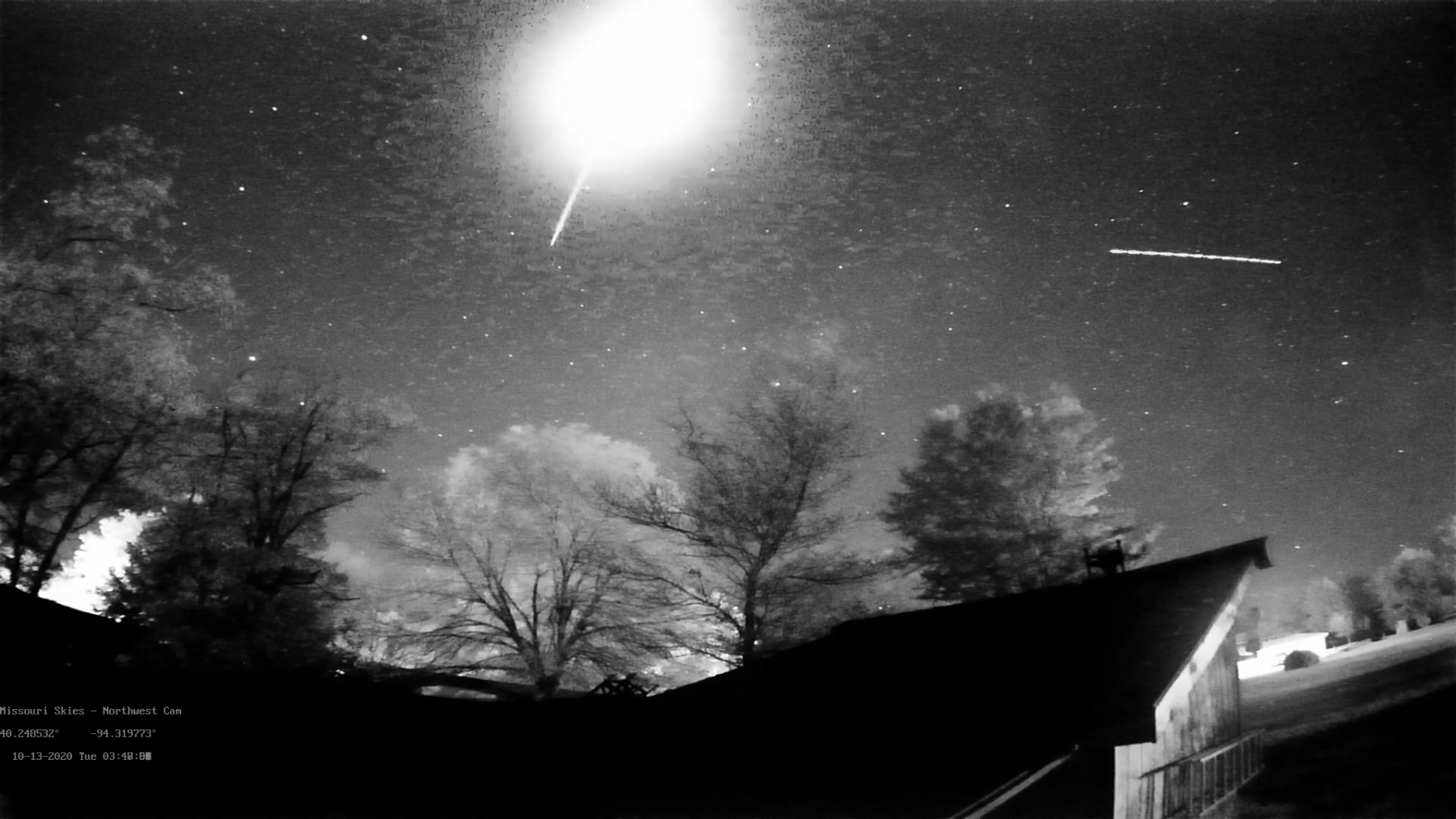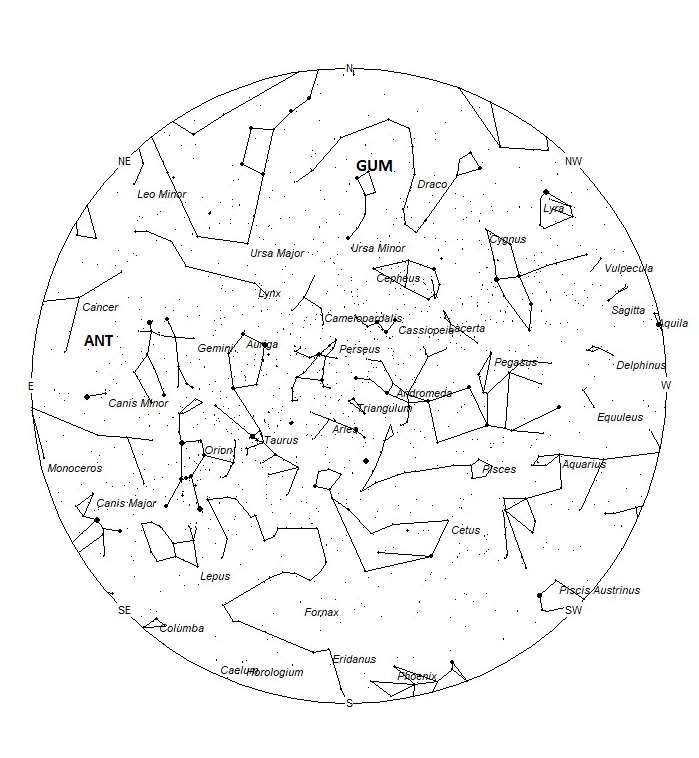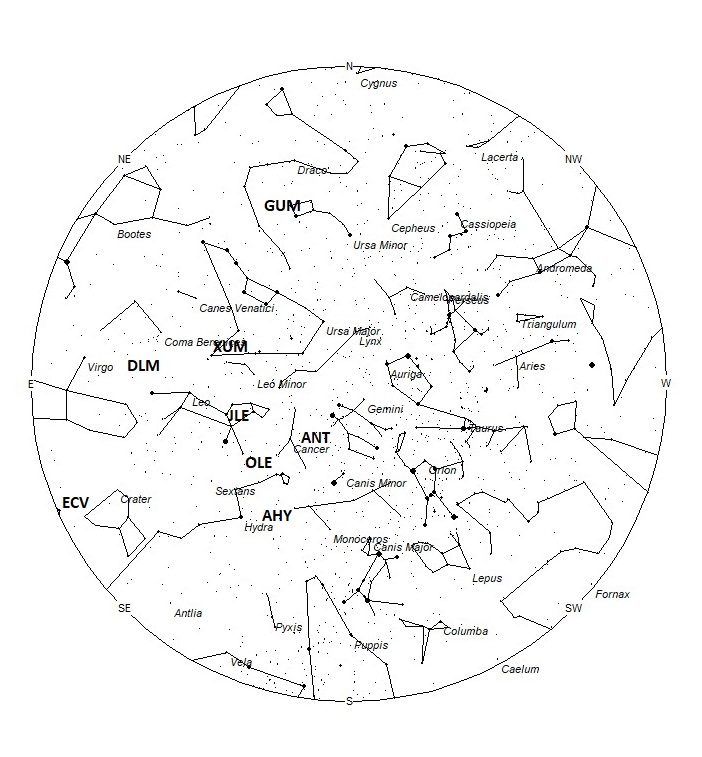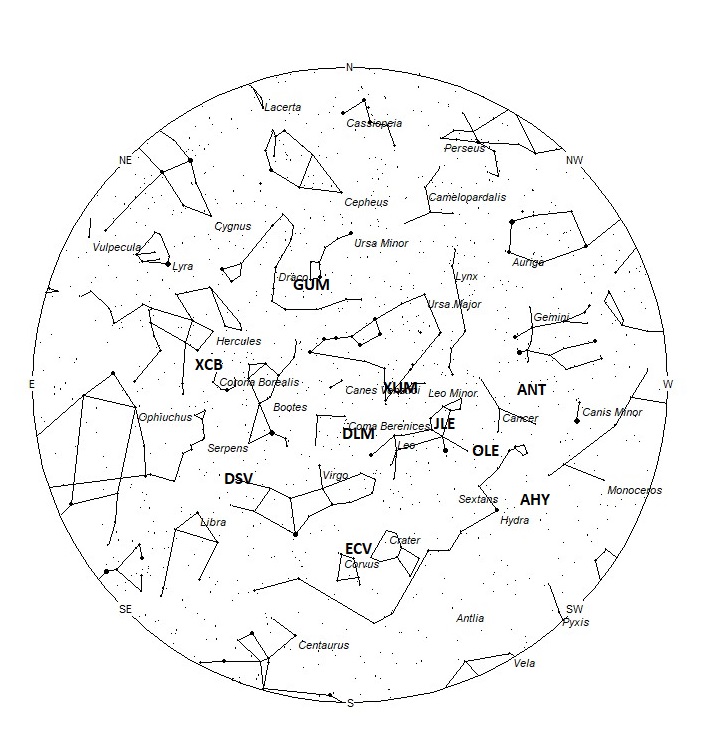
During this period, the moon reaches its new phase on Wednesday January 13th. At this time, the moon is located near the sun in the sky and is invisible at night. This weekend the waning crescent moon will rise during the early morning hours but will not interfere with viewing meteor activity as long as you keep it out of your field of view while observing. The estimated total hourly meteor rates for evening observers this week is near 4 as seen from mid-northern latitudes and 3 as seen from tropical southern locations (25S). For morning observers, the estimated total hourly rates should be near 14 as seen from mid-northern latitudes (45N) and 12 as seen from tropical southern locations (25S). The actual rates will also depend on factors such as personal light and motion perception, local weather conditions, alertness, and experience in watching meteor activity. Note that the hourly rates listed below are estimates as viewed from dark sky sites away from urban light sources. Observers viewing from urban areas will see less activity as only the brighter meteors will be visible from such locations.
The radiant (the area of the sky where meteors appear to shoot from) positions and rates listed below are exact for Saturday night/Sunday morning January 9/10. These positions do not change greatly day to day so the listed coordinates may be used during this entire period. Most star atlases (available at science stores and planetariums) will provide maps with grid lines of the celestial coordinates so that you may find out exactly where these positions are located in the sky. A planisphere or computer planetarium program is also useful in showing the sky at any time of night on any date of the year. Activity from each radiant is best seen when it is positioned highest in the sky, either due north or south along the meridian, depending on your latitude. It must be remembered that meteor activity is rarely seen at the radiant position. Rather they shoot outwards from the radiant, so it is best to center your field of view so that the radiant lies at the edge and not the center. Viewing there will allow you to easily trace the path of each meteor back to the radiant (if it is a shower member) or in another direction if it is sporadic. Meteor activity is not seen from radiants that are located far below the horizon. The positions below are listed in a west to east manner in order of right ascension (celestial longitude). The positions listed first are located further west therefore are accessible earlier in the night while those listed further down the list rise later in the night.
These sources of meteoric activity are expected to be active this week.
.
The Anthelion (ANT) radiant is active from a position located at 08:08 (122) +20. This position lies in western Cancer, 8 degrees northwest of the 4th magnitude star known as Asellus Australis (delta Cancri). This radiant is a very large oval some thirty degrees wide by fifteen degrees high. Activity from this radiant can appear from more than one constellation., Anthelion activity may also appear from Gemini as well as Cancer. There are several lists that have the delta Cancrids currently active, but we include them with the Anthelions as the celestial positions overlap. The position listed here is for the center of the radiant. This radiant is best placed near 01:00 Local Standard Time (LST) when it lies on the meridian and is highest in the sky. Rates at this time should be near 3 per hour as seen from the northern hemisphere and 2 per hour as seen from south of the equator. With an entry velocity of 30 km/sec., the average Anthelion meteor would be of slow velocity.
The alpha Hydrids (AHY) were discovered by Dr. Peter Brown and are mentioned in his article “A meteoroid stream survey using the Canadian Meteor Orbit Radar”. This shower is active from December 16 through January 27 with maximum activity occurring on January 5th. The radiant is currently located at 08:45 (131) -09. This position lies in the western Hydra, 10 degrees west of the 2nd magnitude star known as Alphard (alpha Hydrae). These meteors are best seen near 0200 LST when the radiant lies highest above the horizon. At 43 km/sec. the alpha Hydrids produce meteors of medium velocity. Expected rates this week are near 1 per hour no matter your location.
The Omicron Leonids (OLE) were discovered by Damir Šegon and the Croatian Meteor Network team based on studying SonotaCo and CMN observations (SonotaCo 2007-2011, CMN 2007-2010). These meteors are active from December 16 through February 4. Maximum activity occurs on January 9th. A slight outburst from this source occurred in 2015. If it reoccurs again in 2021, it would happen near 15:59 universal time on January 9. The radiant is currently located at 09:15 (139) +09. This position lies in southeastern Cancer, 6 degrees west of the 4th magnitude star known as omicron Leonis. These meteors are best seen near 0200 LST when the radiant lies highest above the horizon. At 42 km/sec. the omicron Leonids produce meteors of medium velocity. Expected rates this week are less than 1 per hour no matter your location.
The January Leonids (JLE) were also discovered by Dr. Peter Brown and are mentioned in the same publication as the Alpha Hydrids. This shower is active from December 27 through January 11 with maximum activity occurring on January 2nd. The radiant is currently located at 10:11 (153) +22. This position lies in northwestern Leo, 3 degrees northwest of the 2nd magnitude star known as Algieba (gamma Leonis). These meteors are best seen near 0300 LST when the radiant lies highest above the horizon. At 59 km/sec. the January Leonids produce meteors of swift velocity. Expected rates this week are less than 1 no matter your location.
The January xi Ursae Majorids (XUM) were discovered by Japanese observers of SonotoCo based on video observations in 2007-2008. This shower is active from January 10-25, with maximum activity occurring on the 19th. The radiant is currently located at 10:59 (165) +36, which lies in southwestern Ursa Major, 2 degrees north of the 4th magnitude star known as Praecipua (46 Leonis Minoris). These meteors are best seen near 04:00 LST when the radiant lies highest above the horizon. Hourly rates should less than 1 no matter your location. These meteors encounter the atmosphere at 43 km/sec., which would produce meteors of average velocity.
The December Leonis Minorids (DLM) are a shower of long duration active from November 22 through February 10th. Maximum occurred near December 20th. The radiant is currently located at 12:02 (181) +21. This position lies in on the border of Leo and Coma Berenices, 6 degrees northeast of the 2nd magnitude star known as Denebola (beta Leonis). These meteors are best seen near 0500 LST when the radiant lies highest above the horizon. Current hourly rates are expected to be near 1 as seen from the northern hemisphere and less than 1 as seen from south of the equator. At 63 km/sec. the December Leonis Minorids produce mostly swift meteors.
The eta Corvids (ECV) were recently discovered by Sirko Molau and the IMO Video Meteor Network Team. This stream is active from January 16-29, with maximum activity occurring on the 22nd. The current position of the radiant is 12:11 (182) -16, which places the radiant in western Corvus, 2 degrees northwest of the 3rd magnitude star known as Gienah (gamma Corvi A). These meteors are best seen near 0500 LST when the radiant lies highest above the horizon. Current hourly rates would be less than 1 per hour no matter your location. At 67 km/sec. these meteors would be fast.
The December sigma Virginids (DSV) is a source of long duration discovered by John Greaves using the data of SonotaCo. This source is active from November 22 through January 25. Peak rates occurred near December 21st. The current radiant location is at 14:55 (224) +01 which places it in eastern Virgo, 2 degrees southeast of the faint star known as 109 Virginis. Current hourly rates should be less than 1 no matter your location. These meteors are best seen during the last dark hour before dawn, when the radiant lies highest above the horizon in a dark sky. At 66 km/sec. the December Sigma Virginids would produce mostly swift meteors.
The gamma Ursae Minorids (GUM) are another source discovered by Dr. Peter Brown and associates. These meteors are active from January 9-20, with maximum activity occurring near January 18. The radiant is currently located at 15:07 (227) +71 which places it southern Ursa Minor only 1 degree southwest of the 3rd magnitude star known as Pherkad (gamma Ursae Minoris). These meteors are best seen during the last few hours before dawn, when the radiant lies highest in a dark sky. Current rates are less than 1 per hour no matter your location. These meteors encounter the atmosphere at 30 km/sec., which would produce meteors of medium-slow velocity.
The xi Coronae Borealids (XCB) were another source discovered by Dr. Peter Brown and associates. These meteors are active from January 5-25 with maximum occurring near January 15. The radiant is currently located near 16:21 (246) +31, which places it in eastern Corona Borealis, close to the spot occupied by the faint star known as xi Coronae Borealis. Hourly rates would be less than 1 per hour no matter your location. These meteors are best seen during the last dark hour before dawn, when the radiant lies highest above the horizon in a dark sky. At 45 km/sec. this source would produce meteors of medium velocity.
No matter your location, sporadic rates should be near 9 meteors per hour during the last hour before dawn as seen from rural observing sites. Evening rates would be near 3 per hour. Locations between these two extremes would see activity between the listed figures.
The list below offers the information from above in tabular form. Rates and positions are exact for Saturday night/Sunday morning except where noted in the shower descriptions.
| SHOWER | DATE OF MAXIMUM ACTIVITY | CELESTIAL POSITION | ENTRY VELOCITY | CULMINATION | HOURLY RATE | CLASS |
| RA (RA in Deg.) DEC | Km/Sec | Local Standard Time | North-South | |||
| Anthelion (ANT) | – | 08:08 (122) +20 | 30 | 01:00 | 3 – 2 | II |
| alpha Hydrids (AHY) | Jan 05 | 08:45 (131) -09 | 43 | 02:00 | 1 – 1 | IV |
| Omicron Leonids (OLE) | Jan 09 | 09:15 (139) +09 | 42 | 02:00 | <1 – <1 | IV |
| January Leonids (JLE) | Jan 02 | 10:11 (153) +22 | 59 | 03:00 | <1 – <1 | IV |
| January xi Ursae Majorids (XUM) | Jan 19 | 10:59 (165) +36 | 43 | 04:00 | <1 – <1 | IV |
| December Leonis Minorids (DLM) | Dec 20 | 12:02 (181) +21 | 63 | 05:00 | 1 – <1 | II |
| eta Corvids (ECV) | Jan 22 | 12:11 (182) -16 | 67 | 05:00 | <1 – <1 | IV |
| December Sigma Virginids (DSV) | Dec 21 | 14:55 (224) +01 | 66 | 08:00 | <1 – <1 | IV |
| gamma Ursae Minorids (GUM) | Jan 18 | 15:07 (227) +71 | 30 | 08:00 | <1 – <1 | IV |
| xi Coronae Borealids (XCB) | Jan 15 | 16:21 (246) +31 | 45 | 09:00 | <1 – <1 | IV |
 American Meteor Society
American Meteor Society



This info is great!
Thank you, got my scopes ready… spending some time looking, Jan 17-20!
Coincidentally saw one! I was only out looking at the beautiful setting moon and there was one clear meteor that shot right past Orion.